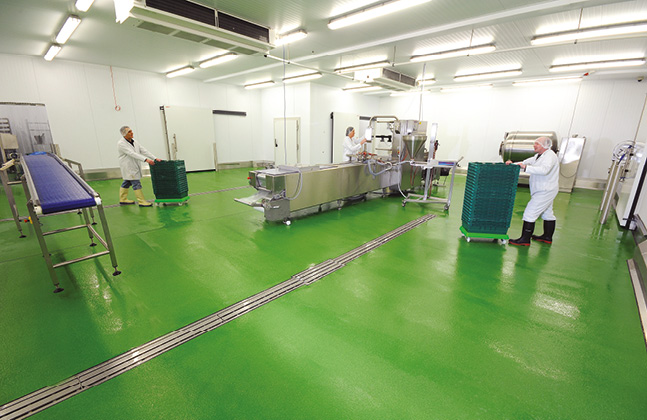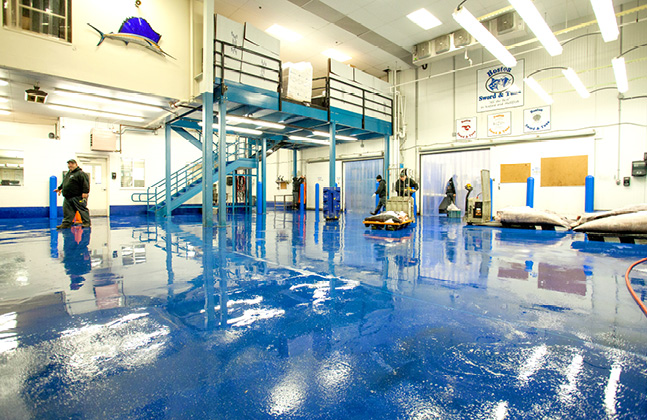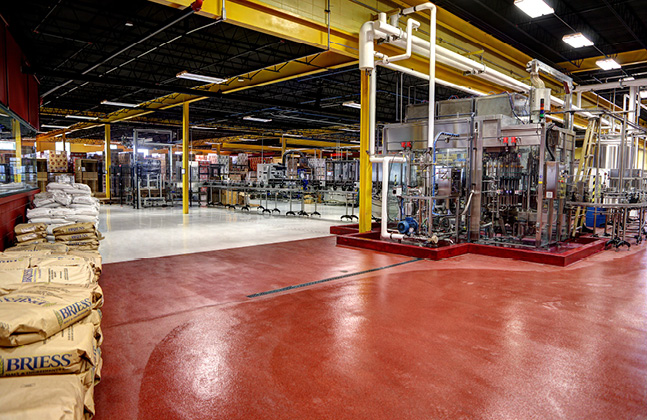Self-levelling (SL) resin floors provide a variety of benefits, not least a smooth and consistent finish – however the floor plan may include a sloped finish, which complicates the application of this type of flooring system.
This can be a particular issue in the food and beverage industry, where it is usually important for the floor to both be laid to a fall and also include large drains. A typical problem for SL floors in this environment is that the resin material could easily run into the drains! Ruining both the drains and the finish in the process.
Don’t “Fall” For a Low Viscosity Floor
Key to this dilemma is the viscosity of the system being applied, essentially the higher the viscosity the more effective it will be when laid to a fall. Bear in mind though that the nominal thickness of the floor will depend on the severity of the slope. For example a 1:80 incline, which is recommended for good drainage in wet areas, will require a nominal thickness of 12.5mm per 1 metre of fall.
By virtue of its low viscosity it’s very difficult to get a SL floor to a 1:80 gradient. A thicker, trowel applied system (Flowfresh HF for example) will be much better suited to the task at hand. To create an effective slope with a thinner, higher viscosity system (Flowshield for example) the gradient would have to be much shallower than 1:80, around about 1:300. In contrast, it is possible to create an exceptionally steep fall of 1:40 using the most viscous of semi dry cement based screeds (such as Isopol underlayment or K-Screed).
What if I Still Want an SL Finish?
If, despite these difficulties, a smooth, SL style finish is still desired for a floor being laid to a fall, then there are a few things that can be tried.
Occam’s razor might suggest simply making the fall shallower, although this could create a cleaning headache further down the line – especially in wet, contamination sensitive food and beverage environments. If the fall is not steep enough then the floor may have to be manually squeegeed to get the liquid out, increasing the amount of time, effort and expense that has to go into the daily cleaning regime.
Alternatively, a thick underlayment (such as the epoxy screed Flowtex) could be laid to the desired fall, which would then act as the substrate for a subsequent coating with a thinner, smoother, SL finish.
Another solution would be to look for a suitable solution with quartz encapsulated within the floor’s resin matrix. The dense nature of these systems is ideal for laying to a fall and the quartz built into the floor even creates an aesthetically pleasing, dappled surface.
Analyse the Fall Before, During and After Application
When specifying the floor make sure to discuss the fall that needs to be achieved with both the supplier and applicator to ensure that the finish will meet the site’s needs. Once the floor has been completed, the effectiveness of the fall can be tested by pouring water onto its surface and checking that it runs in the right direction at the right speed.
If you’d like to know more about what flooring solution will work best in a particular location, get in touch with Flowcrete UK’s resin flooring experts by calling 01270 753000 or emailing ukweb@flowcrete.com.
In the next technical bulletin Gary Chapman, Flowcrete UK’s Technical Advisor, explains when a floor build up will require a damp proof membrane. If you’ve got a question about resin flooring that you’d like answered by one of our experts, just leave it in the comments section below.
2 thoughts on “Technical Bulletin 2: Can I Lay a Self-Levelling Resin to a Fall?”
Comments are closed.








Gary
We have a problem with a changing room area and need to rectify the falls, at the moment the falls are away from the outlets and we would like to suggest to the original installer a solution.
If you come back to me with your email I can send through some plans and photos
Hi Karen
Many thanks for your comment.
I’ll drop you an email regarding this now so that we can get the ball rolling on finding the best solution for your floor.
Kind regards,
Dan